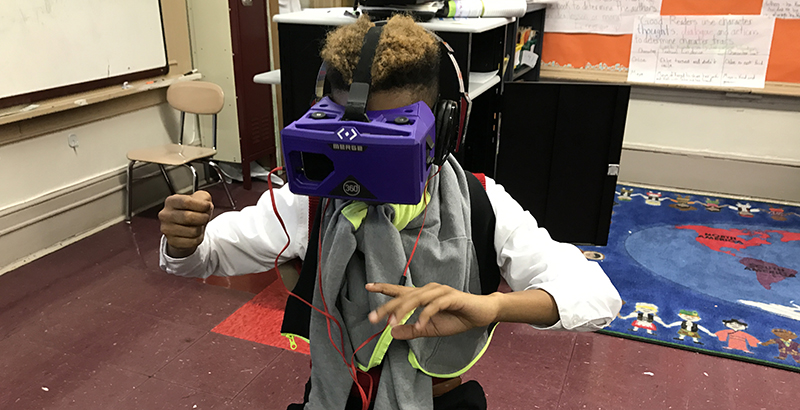Begun in NYC Public Schools, Techrow Makes Virtual Reality Work for Students of All Income Levels, No Matter Where They’re Learning

With students stuck at home during the pandemic, disengagement from school has turned from concern to danger. But with the challenge of distance learning comes an opportunity for virtual reality to create accessibility and understanding for kids of all demographics, even in the most disadvantaged districts.
Travis Feldler saw firsthand how early in their educational careers students could fall into “academic arrest,” while he was working for New York state’s economic development office. Determined to break that vicious cycle of disinterest, he took his experience in education technology and teamed up with 10 students at Harlem’s Thurgood Marshall Academy to come up with a tool for engaging fifth-graders in science and math through virtual reality.
To be usable and scalable, he says, it would have to operate well in public schools with low-income student populations. It would have to be easy for teachers to use and engage students academically. And Feldler wanted it to be inclusive, both in content and access.
By 2019 — just a few years later — his company, Techrow, had 2,000 students per day in New York and Los Angeles connecting to education in ways they hadn’t before.
“Schools loved what we were doing, educators were excited and students were engaged in subjects they would not traditionally be engaged in,” he says.
The Techrow platform is compatible with any VR headset, from the fanciest, most expensive version to the basic smartphone-plus-cardboard-viewer. It works with limited Wi-Fi, can accommodate students with special needs and is cloud-based, so it is accessible both in the classroom and at home.
Top media providers, such as the New York Times and BBC, have partnered with Techrow to build a library of content categorized for teachers, aligned with curriculum standards. The content is high-budget, delivering to students the videos of the quality they are accustomed to watching for their own entertainment. Techrow also developed accompanying lesson plans, and teachers can have full control — in the classroom, for example, they can run the content from their own device, stopping or pausing videos when needed. And by integrating with learning management systems, such as Google Classroom, teachers can, say, select Mission to Pluto or Exploring Pluto’s Frigid Heart as a homework assignment.
“The immersive experience of virtual reality sets it apart and engages students in a novel way despite the myriad of technological resources available,” says Abdur Rahman, a teacher at New York’s New Design Middle School.
“We have evidence that this improves their abilities to take on new perspectives, empathize with others and, therefore, add depth to their own lives,” New Design teacher Mark Lee says.
Feldler says his model is usable in all learning environments, from the classroom to distance learning.
“Our roots in the most underserved schools in New York City have given us a very strong mission to stay aligned to the needs of the sector and not build from the top of an ivory tower,” he says. “Sometimes tech can get too far out there where you can’t use it.”
From its initial focus on fifth-graders, Techrow has switched to middle and high school students. But the company is also building a catalog of content that not only fits the academic needs of younger students, but is also usable without a VR headset, so kindergartners can more easily access the videos.
As the 10-employee company looks to expand beyond the nation’s two largest school districts — it has already launched in Indianapolis — and build out its network of media partners, it wants to continue offering inclusive curriculum that provides opportunities for all students to experience different perspectives. Feldler says the right content can help students of color see themselves as part of the future and aid white students in imagining a more diverse world.
“We have a responsibility to mitigate learning loss, increase engagement and close learning gaps,” Feldler says. “Immersive technology is a catalyst.”
Get stories like these delivered straight to your inbox. Sign up for The 74 Newsletter

;)
